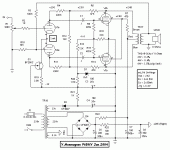This thread brought back to life by a request for explanation of Schade FB & why it is a problem.
All beat to death for our pleasure.
I've got more to go on this one, why a pentode input stage still makes sense with Schade FB.
When time allows, finally Spring here for a few daze, I'm running hard. 😀
All beat to death for our pleasure.
I've got more to go on this one, why a pentode input stage still makes sense with Schade FB.
When time allows, finally Spring here for a few daze, I'm running hard. 😀
Hi John, I have built this amplifier and it sounds very nice. The source webpages contain a PDF with the performance data you appreciate.
Dissident Audio - ECL86 PP
To my untrained eye it looks like a variant of Schade, but crosslinked. Does this ameliorate the issues you raised?

Finally the snow has disappeared here in Sweden too, so the jobs pile up fast.
Cheers, Richard
Dissident Audio - ECL86 PP
To my untrained eye it looks like a variant of Schade, but crosslinked. Does this ameliorate the issues you raised?

Finally the snow has disappeared here in Sweden too, so the jobs pile up fast.
Cheers, Richard
To analyze this circuit, imagine R12 divided into two equal halves (of 6K Ohm each) with center point at signal ground. Feedback voltage across each of these half resistors is output anode signal voltage times 47K / (most of) 6K. Call it maybe 1/8 of anode signal voltage. At the driver anode end of R4/R11 (also output valve G1) is signal voltage (some amount) and at the other end ("top") is that (some) amount times gain of the output valve divided by 8 and inverted in polarity. The driving valve's anode load is reduced by feedback by the factor of (gain of output valve / 8) +1.
So, much less loading effect, but also the same proportion less feedback. No free lunch.
All good fortune,
Chris
So, much less loading effect, but also the same proportion less feedback. No free lunch.
All good fortune,
Chris
At first glance it looks like the 'Baby Huey', a very popular circuit.
Perhaps the full loop NFB fixes some problems if they exist. Needs a closer look.
Rain next week, maybe time for a careful look. Very dry here now,, fire hazard in the bush.
Perhaps the full loop NFB fixes some problems if they exist. Needs a closer look.
Rain next week, maybe time for a careful look. Very dry here now,, fire hazard in the bush.